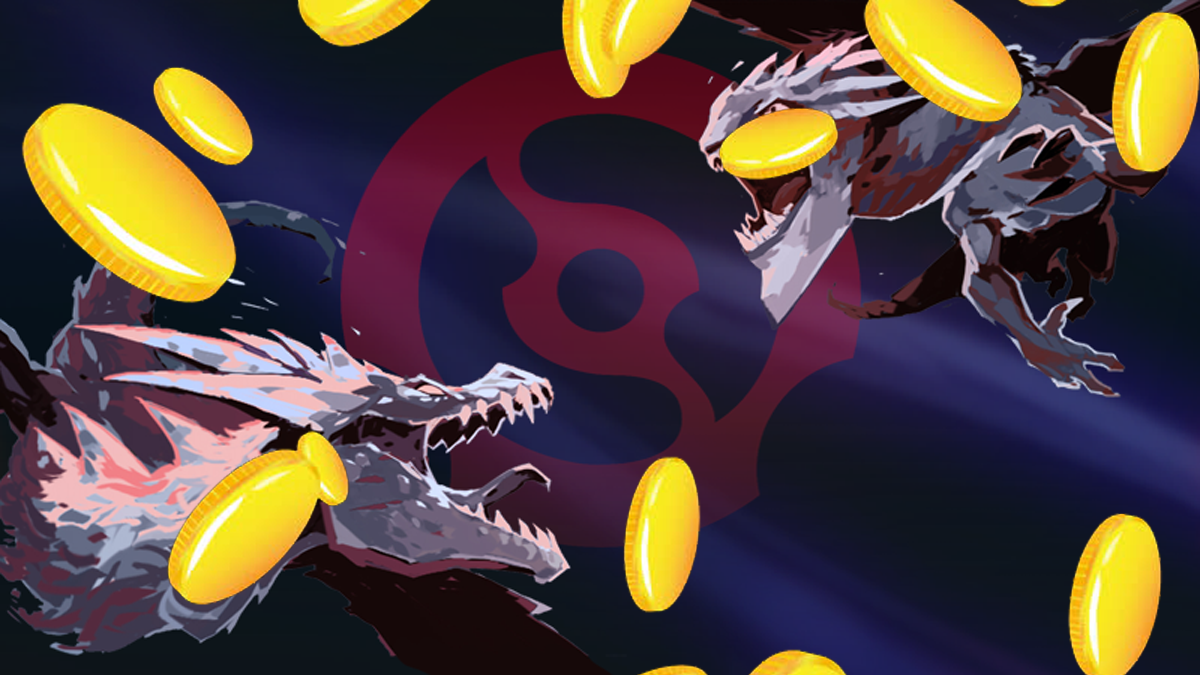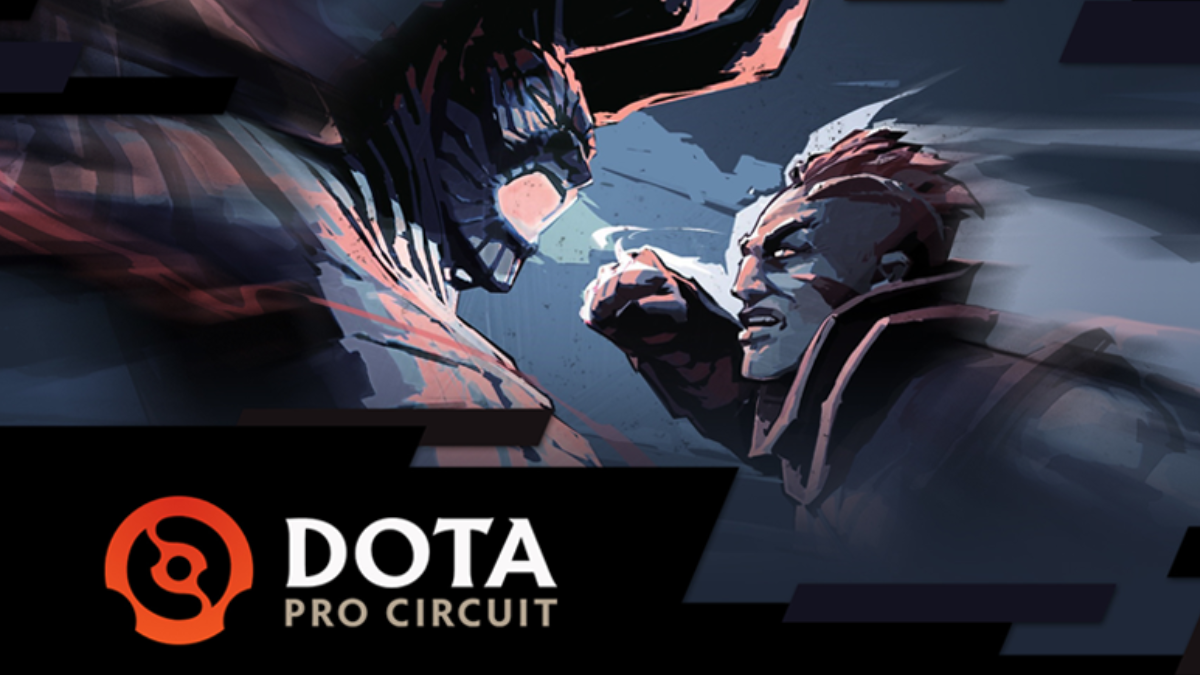As the years have gone by, the professional Dota 2 scene has seen a massive dip in non-TI prize pools even with a seemingly more structured system in place.
For a casual observer who enjoys the biggest events in multiple esports, it might seem like Dota 2 is killing it. The game can boast about having the highest prize pool tournament, The International, the prize pool for which keeps increasing each year. Last year, it overtook $40 million, a milestone most games can’t even dream of achieving.
Surely, with that much money being put into an event, the Dota 2 scene must be in a peachy place, right? If that were the case, I wouldn’t be writing this article. After Valve’s most recent debacle about cancelling the first DPC Major of the 2021-2022 year out of nowhere, the players, talent and community as a whole are up in arms. This makes it the best time to take a look at how the money in professional Dota 2 besides the TI prize pool has seen a dip as the years have gone by, and how it is becoming more of a challenge to make it to the top in one of the biggest esport titles this world has seen.
Prize money in Dota 2
Thanks to the community contribution via Battle Pass, the prize pool of The International has gone up significantly in the past few years. Going from TI5 to TI10, it has more than doubled $18.42 million to a staggering $40.01 million! This is very positive, no doubt. Besides the initial $1.6 million put in by Valve, the rest of the prize pool is crowd funded, which is testament to the fact that the community loves this game and wants to see the professional scene develop well. Well, that and the fact that most of us are addicted to Battle Passes.
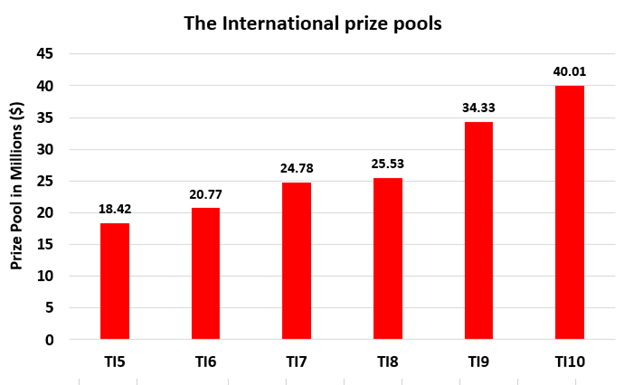
So if the premier Dota 2 tournament of the year has seen such colossal increases in prize money, shouldn’t that reflect in the rest of the year as well? In an ideal world, yes. But we live in a world which is far from ideal. The bar graph below shows how the non-TI prize pools have varied over the past five years.
This is the stat that matters most for the scene; the stat that shows how much potential there really is for upcoming teams to be able to sustain themselves until they can break into the top tier and start making a good living for themselves. And it pains to see that even though the overall prize money in Dota 2 has gone up (solely due to The International prize pool), the non-TI has prize pool has plummeted. Just as the TI prize money has more than doubled in six years, the non-TI prize money in 2020-2021 fell to less than half of what it was in 2017-2018. While considering all the tournaments in 2020-2021, the Division I and Division II DPC Leagues from all six regions have been taken into account.
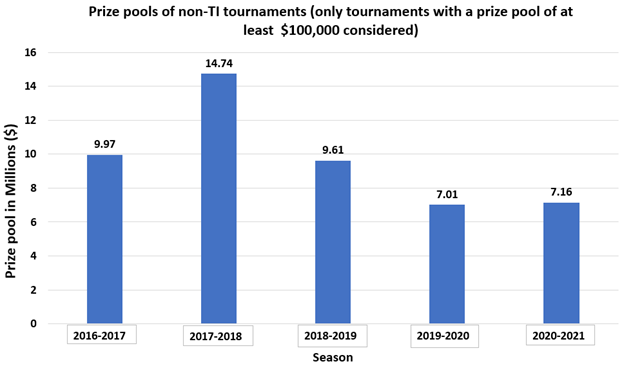
Has Covid-19 been a factor in the last two years? Of course it has. Even the most stringent Valve critic will admit that the tournaments have reduced due to the pandemic. But even though that might be the case, the fact remains that one DPC season is a 10-12 week process, in which teams are fully focused on their league games because that is what will get them to TI, and majority of the prominent tournament organizers are hosting the DPC Leagues, making it more difficult to plan tournaments outside the DPC Leagues and Majors.
How’s Valve doing in all this with respect to Dota 2? I think they’ve been doing pretty well for themselves through TI Battle Pass sales. And I say TI Battle Pass sales, because there are other Battle Passes as well, which do not fund any tournaments and 100% of the revenue goes to Valve. For those ones, like the Nemestice Battle Pass or the Aghanim’s Labyrinth Battle Pass currently in the game, we don’t even know what the revenue is. For the TI Battle Passes, considering 25% goes to The International prize pool, it is an easy calculation to determine how much Valve ended up pocketing. And just as the TI prize pools have skyrocketed, so has the money made by Valve in the past few years.
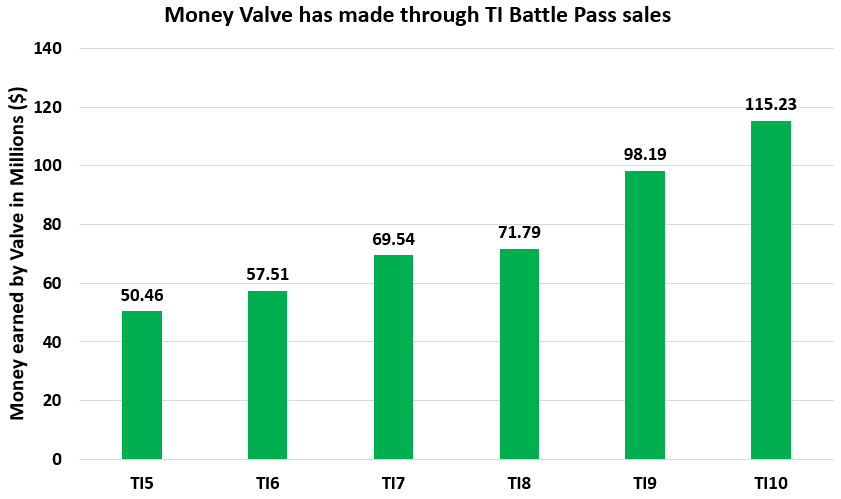
Now granted, that not all of this ends up as profit for the company. There are quite a few organizations and artists to pay for making The International happen smoothly, which Valve have been doing alright. Credit where credit is due. TI has always delivered and for the most part, production has gotten better with the years. However, the production costs surely do not scale in a similar manner as the prize pool. The crux of it is, Valve is ending up pocketing a significantly high amount from just the TI Battle Pass, and the result of it has been diminishing opportunities during the rest of the year.
Battle Passes
Years ago, there were two and sometimes even three Battle Passes in a Dota 2 year (Post TI to next TI). There was the TI Battle Pass, and there were also Winter and Fall Battle Passes, money from which was used to fund the initial Valve Majors, that had prize pools of $3,000,000! That was like a mini TI, the same format and the same intensity.
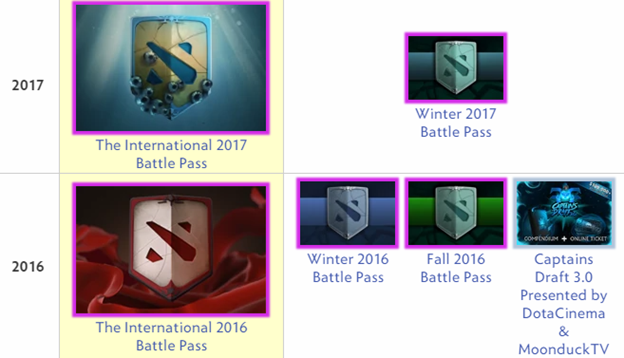
Of late, the Battle Passes seem to be increasing and there is no account of where the money is going. Neither the revenue from the two most recent Battle Passes – the Nemestice Battle Pass and the Aghanim’s Labyrinth Battle Pass hasn’t been revealed nor has it been mentioned where it will be used, if anywhere. The most recent hero to win the arcana vote – Spectre – had her arcana embedded in a Nemestice Battle Pass, which meant players would have to spend closer to $150 instead of the typical $34, to get the arcana that the community literally voted for. In short, all the tactics point to sucking the community dry by putting the same toy in front of them, wrapped in a different colored shiny paper. And it works, because we have become suckers for it.

Dota Pro Circuit Seasons
The DPC Leagues were introduced in the post-pandemic rejuvenation of Dota 2. TI10 was postponed by a year and in the vacuum that was left (there were a lot of online regional tournaments), Valve came up with the regional league system that would ensure more competitive games and eyes on tier 2 and tier 4 teams. In theory, well and good. But there are glaring issues with the leagues that a lot of professional players have spoken about, and these issues tie back to a lack of time for other events and a reduction in tournament prize pools. Let’s take a look at what some of the EU players have had to say about the DPC Leagues and DPC Majors.
Lasse Aukusti “Matumbaman” Urpalainen speaking with Monster Gaming:
"I like the DPC Leagues and the fact that the number of Majors has been increased to three, but I would definitely shorten the duration of the leagues. It would also be nice to see the old Majors be brought back – the Eaglesongs and Mystic Staffs for trophies and, even though not realistic, the $3 million prize pool can be a massive incentive for players."
Ludwig “Zai” Wahlberg talking with Team Liquid:
"The points and Majors have moved in the right direction, but I’d say the DPC Leagues should be shorter with teams playing two games a week instead of just one. That would make space in the year for other things like third party tournaments, which is hard to fit in with the current system."
Two time TI winner and current OG coach Johan “n0tail” Sundstein made his thoughts on playing in the DPC Leagues and DPC Majors known on YouTube:
Similar thoughts were also echoed by Quinn “Quinn” Callahan in his recent Twitch discussion after the news about the Major cancellation was revealed.
The Leagues take up a lot of time and the prize money from the leagues isn’t too enticing either. Take a team like 4Zoomers, who had decent players in the first two seasons of the DPC Leagues. They ended up in 4th place in Division I of the NA DPC League in both seasons, earning them $26,000 in each season. Ignoring payments to team members like a manager and a coach, that nets every player $10,400 over two seasons, which in the United States and a lot of countries in Europe is peanuts. I have lived in India and the USA and have a good idea of the amount of money needed to sustain oneself while chasing a dream – In Southeast Asia, that might be enough. In the Western world, it is woefully low. And this, we are talking about the fourth best team in North America. Think of all the teams below them, who have the hunger, drive and passion, but just need more time. Samuel “SammyBoy” Andersen, who was a part of that 4Zoomers team and who is playing with Wildcard Gaming this year, had this to say when the Major was cancelled:
It gets even worse for Division II teams. The prize pool gets bleak and if you’re in the bottom two, you get nothing – $0 – for all the time and effort put into the game. There will be people who argue that it will motivate teams to perform better, but it isn’t like a slightly higher placement will get you a lot more money. A sixth place finish in Division II is just $7,000 for an entire team. I am a PhD student, and we always joke about being underpaid, but looking at the prize money for Division II teams, I’ve begun to feel rich. No Bounty Hunter were recently disqualified from the Division II Western EU League due to forfeiting more than the permissible number of games, something they had to do as players work multiple jobs.
Of course, the solution is not to throw heaps on money at Division II. That can also have a negative effect, as I’ve seen happen in the Indian Dota 2 scene. ESL poured in a ton of money into the Indian Dota 2 scene, the top teams got complacent thinking they could earn a decent living in just the local tournaments, not a single one made a mark in even SEA, and eventually, the money stopped coming, crashing the scene. But it should at least be enough to honor the efforts put in by players, and keep them motivated to continue to get better.
Now why, you may ask, do teams keep trying to get into the DPC Leagues and continue to play the leagues? Because it is the only way to make it to The International and earn a decent paycheck to support your dream of playing the game you love for another year. This of course, does not apply to the top teams that significantly outearn the ones on the cusp of having a breakthrough. But event the top teams, who face a lot of burnout post TI, do not have the option of sitting out of the seasons to re-energize themselves, as it will lead to relegation to Division II. Even though it might be good for viewers, the system is flawed in multiple ways against players. If this continues, the number of players motivated to make it big in professional Dota 2 will dwindle.
The crux of all this is that:
● The new system is flawed
● It makes life harder for players in multiple ways
● There isn’t too much time for third party events to take place
● The result of it all is more money into the pocket of Valve and less money in non-TI tournaments for teams to fight for
● No growth of the scene, even though that’s what the system aims at
Do I have all the solutions? Admittedly, I do not. But it is important that the issues are brought to the fore so that the ones in charge take actions to improve the current conditions. Dota 2, after all, is the game we all love and the players, casters and community alike would love to see it prosper in all aspects. The question is, what does Valve want?

